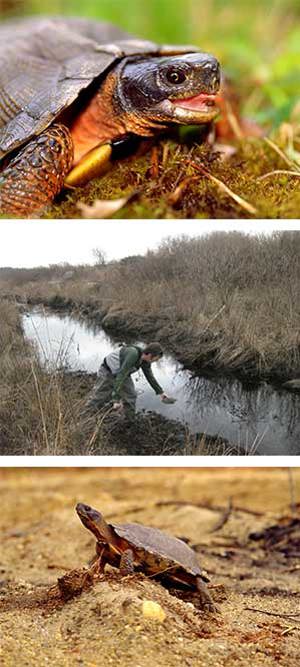Zoo New England and MassWildlife partner to study and monitor wood turtles
Thursday April 11, 2019
 Zoo New England and the Massachusetts Division of Fisheries and Wildlife (MassWildlife) are partnering to conserve wood turtle populations in eastern Massachusetts.
Zoo New England and the Massachusetts Division of Fisheries and Wildlife (MassWildlife) are partnering to conserve wood turtle populations in eastern Massachusetts.
During this three year project—which will begin this spring—Zoo New England, in partnership with MassWildlife will:
- Obtain wood turtle population data in eastern Massachusetts streams;
- Identify key habitat management needs and document wood turtle movements;
- Locate and protect wood turtle nesting sites;
- Identify suitable but unoccupied turtle habitats for restoration efforts; and
- Raise hatchling wood turtles (headstarting) to be released and tracked near their original hatching site.
“Zoo New England is delighted and honored to partner with MassWildlife in developing a long-term conservation strategy for wood turtles in eastern Massachusetts. Through our Grassroots Wildlife Conservation program, Zoo New England is restoring populations of a number of rare animal and plant species that live in Massachusetts. In each case, we work closely with the biologists of MassWildlife,” said Dr. Bryan Windmiller, Zoo New England’s Director of Conservation, who has extensively studied and worked with wood turtles, Blanding’s turtles, and other rare reptile and amphibian species in Massachusetts for more than 30 years.
“The wood turtle was formerly distributed in most of the cool, free-flowing streams of the Merrimack River Valley. Wood turtle populations close to Boston have declined substantially as a result of severe habitat fragmentation,” said Dr. Mike Jones, MassWildlife State Herpetologist. “However, a few small populations persist in eastern Massachusetts. It’s now clear that these remaining populations are small and isolated, and in need of focused and sustained management efforts to persist. This partnership with Zoo New England provides a timely opportunity to understand and implement the most pressing management needs for wood turtles in eastern Massachusetts.”
Zoo New England’s staff will search in stream habitats to find wood turtles, track movement patterns and habitat use with radio telemetry, and identify unoccupied areas where wood turtles might successfully be restored in northeastern Massachusetts. Restoration efforts will include raising juvenile hatchlings to a size where they are less vulnerable to predators (headstarting), outfitting them with tracking devices, and releasing them either in the area where they hatched or a nearby, suitable reintroduction site.
Wood turtles are listed as a Species of Special Concern under the Massachusetts Endangered Species Act. The wood turtle is so-named because its carapace, or top shell, looks like carved wood. These medium-sized turtles grow to about 6–8 inches in length and are found in small populations throughout stream habitats in Massachusetts. Though few hatchlings survive to adulthood, once wood turtles reach maturity they can live to more than 70 years. As adults, wood turtles have few predators but are vulnerable to road casualties, forestry and agricultural activities, streambank development, and pesticide and heavy metal pollution in waterways.
Zoo New England staff has a proven track record of success with turtle conservation programs, most notably with Blanding’s turtles and Northern red-bellied cooters. For over 20 years, Zoo New England worked with MassWildlife on the successful Northern red-bellied cooter headstart program—over 4,000 turtles have been released since the program’s inception in 1985. Zoo New England’s Grassroots Wildlife Conservation staff has worked on Blanding’s turtle conservation since 2003, and began the headstart program for this species in 2007. Hatchling turtles are captured and raised over 8–9 months, resulting in yearlings the size of 3-year-olds at the time of release, giving each turtle an excellent chance of surviving to adulthood. Through the ZNE Grassroots Wildlife Conservation’s innovative community-based outreach and resource initiatives, thousands of schoolchildren and volunteers have engaged in on-the-ground rare species conservation efforts focused on species including Blanding’s turtles, eastern spadefoot toads, bridle shiners, marbled salamanders, and New England blazing star.
Photos 1 and 3 courtesy of MassWildlife.

